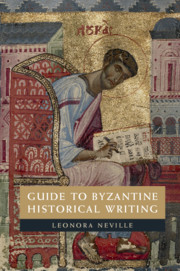Book contents
- Frontmatter
- Dedication
- Contents
- Acknowledgments
- Introduction
- Byzantine Historical Texts
- 1 Theophylakt Simokatta
- 2 Paschal Chronicle
- 3 George Synkellos
- 4 Chronicle of Theophanes
- 5 Patriarch Nikephoros
- 6 Scriptor Incertus de Leo V
- 7 Chronicle of 811
- 8 Megas Chronographos
- 9 George the Monk
- 10 Peter of Alexandria
- 11 Genesios
- 12 Theophanes Continuatus
- 13 Constantinian Excerpts
- 14 John Kaminiates
- 15 Symeon the Logothete
- 16 Leo the Deacon
- 17 Chronicle of Monemvasia
- 18 Chronicon Bruxellense
- 19 Psellos
- 20 John Xiphilinos
- 21 Michael Attaleiates
- 22 John Skylitzes and Scylitzes Continuatus
- 23 George Kedrenos
- 24 Nikephoros Bryennios
- 25 Anna Komnene
- 26 John Kinnamos
- 27 John Zonaras
- 28 Constantine Manasses
- 29 Michael Glykas
- 30 Eustathios of Thessaloniki
- 31 Joel
- 32 Niketas Choniates
- 33 George Akropolites
- 34 Theodore Skoutariotes
- 35 George Pachymeres
- 36 Nikephoros Gregoras
- 37 Ephraim
- 38 Constantine Akropolites the Grand Logothete
- 39 Chronicle of Morea
- 40 Nikephoros Kallistos Xanthopoulos
- 41 John VI Kantakouzenos
- 42 Michael Panaretos
- 43 Chronicle of Ioannina
- 44 Chronicle of Tocco
- 45 John Kananos
- 46 John Anagnostes
- 47 Leontios Machairas
- 48 Sylvester Syropoulos
- 49 Doukas
- 50 George Sphrantzes
- 51 Michael Kritovoulos
- 52 Laonikos Chalkokondyles
- Appendix A Time Periods Covered in the Histories
- Appendix B Timeline of Authors’ Lives
44 - Chronicle of Tocco
from Byzantine Historical Texts
Published online by Cambridge University Press: 14 June 2018
- Frontmatter
- Dedication
- Contents
- Acknowledgments
- Introduction
- Byzantine Historical Texts
- 1 Theophylakt Simokatta
- 2 Paschal Chronicle
- 3 George Synkellos
- 4 Chronicle of Theophanes
- 5 Patriarch Nikephoros
- 6 Scriptor Incertus de Leo V
- 7 Chronicle of 811
- 8 Megas Chronographos
- 9 George the Monk
- 10 Peter of Alexandria
- 11 Genesios
- 12 Theophanes Continuatus
- 13 Constantinian Excerpts
- 14 John Kaminiates
- 15 Symeon the Logothete
- 16 Leo the Deacon
- 17 Chronicle of Monemvasia
- 18 Chronicon Bruxellense
- 19 Psellos
- 20 John Xiphilinos
- 21 Michael Attaleiates
- 22 John Skylitzes and Scylitzes Continuatus
- 23 George Kedrenos
- 24 Nikephoros Bryennios
- 25 Anna Komnene
- 26 John Kinnamos
- 27 John Zonaras
- 28 Constantine Manasses
- 29 Michael Glykas
- 30 Eustathios of Thessaloniki
- 31 Joel
- 32 Niketas Choniates
- 33 George Akropolites
- 34 Theodore Skoutariotes
- 35 George Pachymeres
- 36 Nikephoros Gregoras
- 37 Ephraim
- 38 Constantine Akropolites the Grand Logothete
- 39 Chronicle of Morea
- 40 Nikephoros Kallistos Xanthopoulos
- 41 John VI Kantakouzenos
- 42 Michael Panaretos
- 43 Chronicle of Ioannina
- 44 Chronicle of Tocco
- 45 John Kananos
- 46 John Anagnostes
- 47 Leontios Machairas
- 48 Sylvester Syropoulos
- 49 Doukas
- 50 George Sphrantzes
- 51 Michael Kritovoulos
- 52 Laonikos Chalkokondyles
- Appendix A Time Periods Covered in the Histories
- Appendix B Timeline of Authors’ Lives
Summary
This text is a verse chronicle detailing events in Epirus from 1375 to 1422. It is an important witness to the politics and culture of the region. The beginning and ending are lost, and the name “Chronicle of Tocco” has been given to the text because it focuses on the reign of Charles I Tocco, who is presented as a great hero. Charles I Tocco was a member of an Italian family settled in northern Greece since the middle of the fourteenth century. He ruled as Despot of Epiros from 1411 to 1429. The chronicle presents events in western Greece, particularly Ioannina and the islands of Zakynthos, Kephalonia, and Ithaka.The chronicle is written in fifteen- syllable “political” verse, of which 3,923 verses survive. The verse is in vernacular Greek and provides some insight into the fifteenth- century language. It sometimes uses Italian words and phrases.
Nothing is known of the author. He would seem to be contemporary with the events described. The text displays a local worldview in which events in Constantinople are distant. Kazhdan has suggested that the chronicle may have originally been written in Italian, given that the author views the Tocco family so favorably. Yet it is also possible that the Charles Tocco had succeeded in winning the favor of some Greeks.
Manuscripts, Editions, and Translations
Manuscripts
The main manuscript, Vaticanus Graecus 1881, is from the middle of the fifteenth century. This has corrections in the same hand as the main text, which led Schir o to argue it was the author's autograph. Given the poor shape of the text, Kazhdan finds this doubtful. Vaticanus Graecus 2241 is the work of Nicholas Sofianos in the 16th century, and is a copy of Vaticanus Graecus 1881.
Edition
Schiro, Giuseppe, ed. Cronaca dei Tocco di Cefalonia. Translated by Giuseppe Schiro. Corpus Fontium Historiae Byzantinae 10. Rome : Accademia nazionale dei Lincei, 1975. This is the first edition of this text.
- Type
- Chapter
- Information
- Guide to Byzantine Historical Writing , pp. 278 - 280Publisher: Cambridge University PressPrint publication year: 2018

